
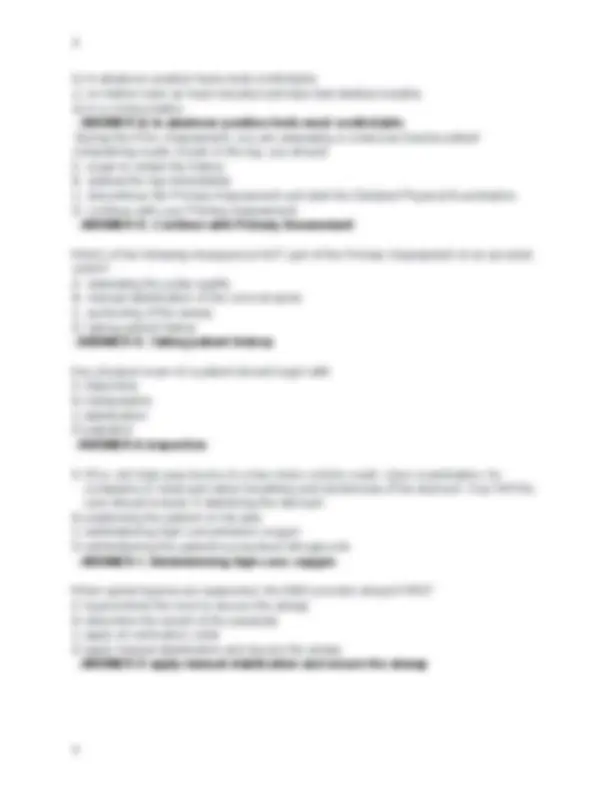
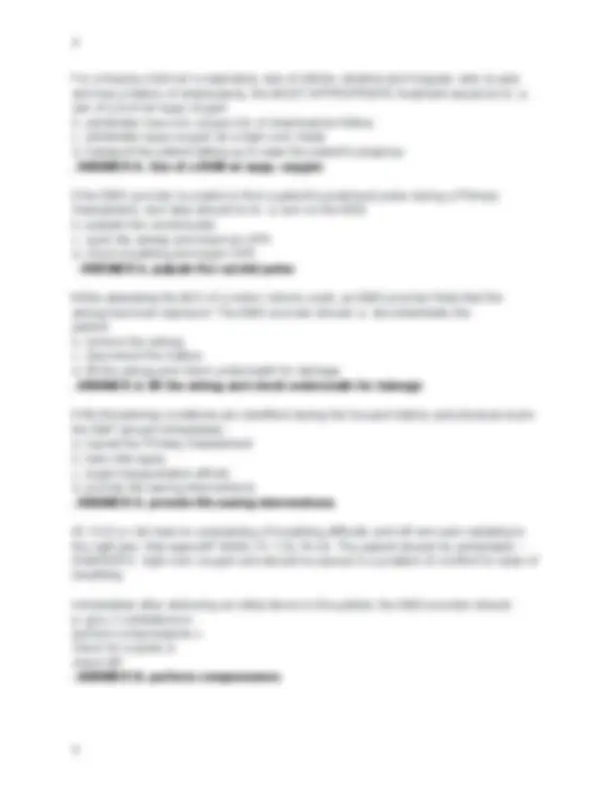
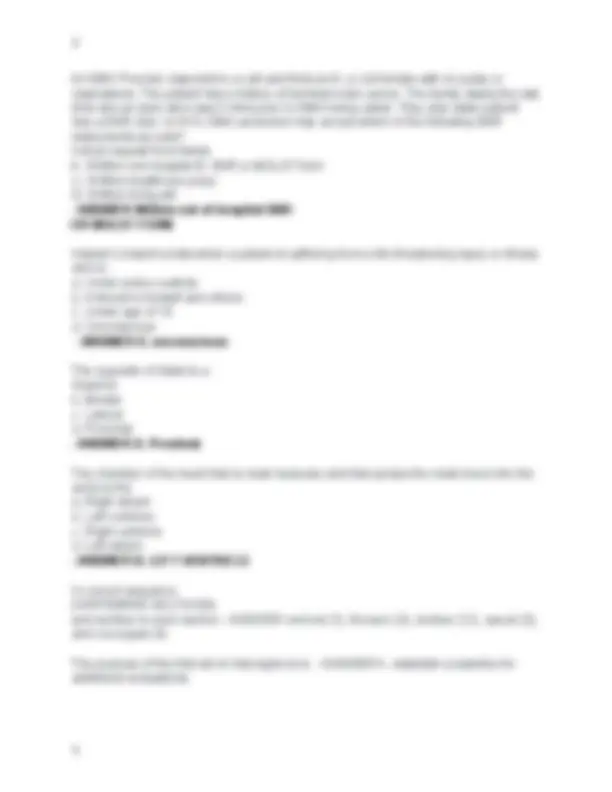
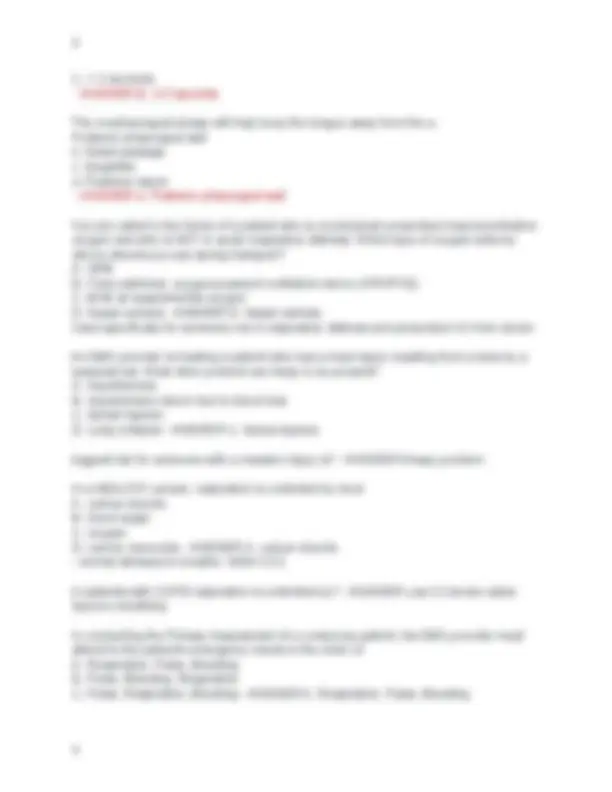
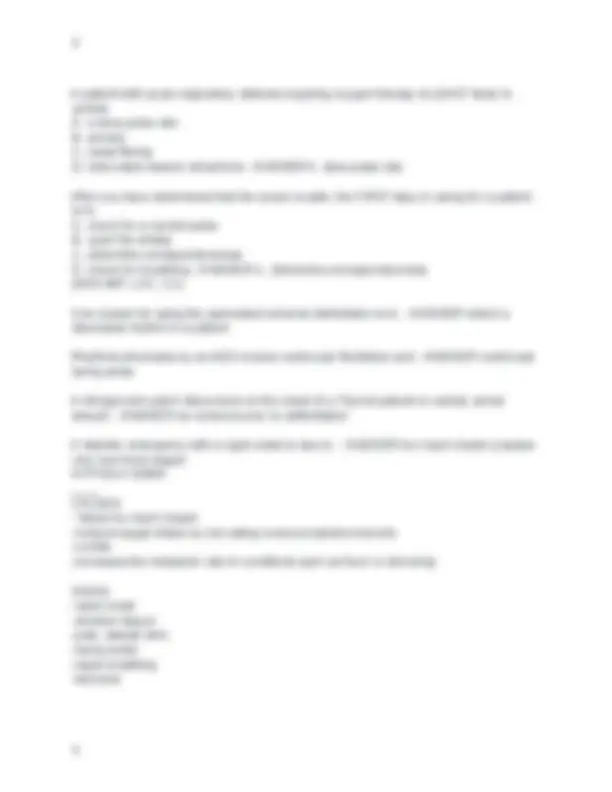
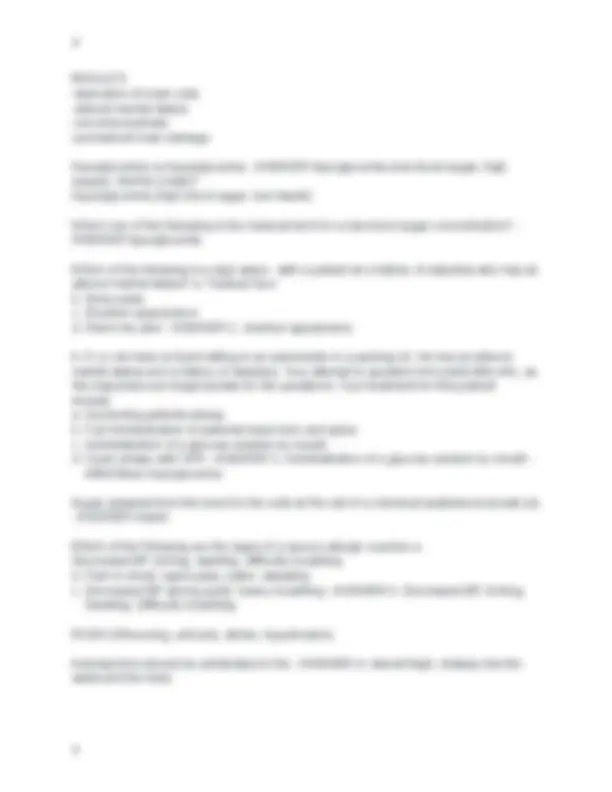
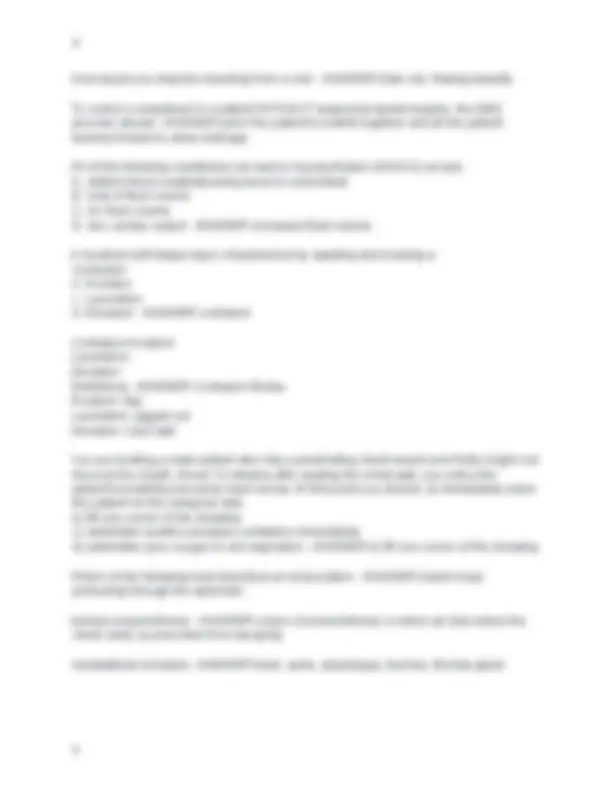
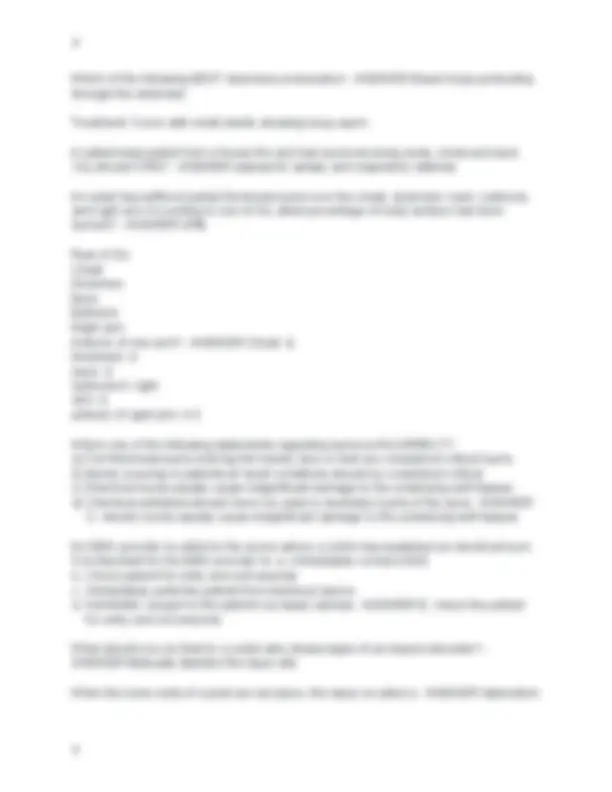
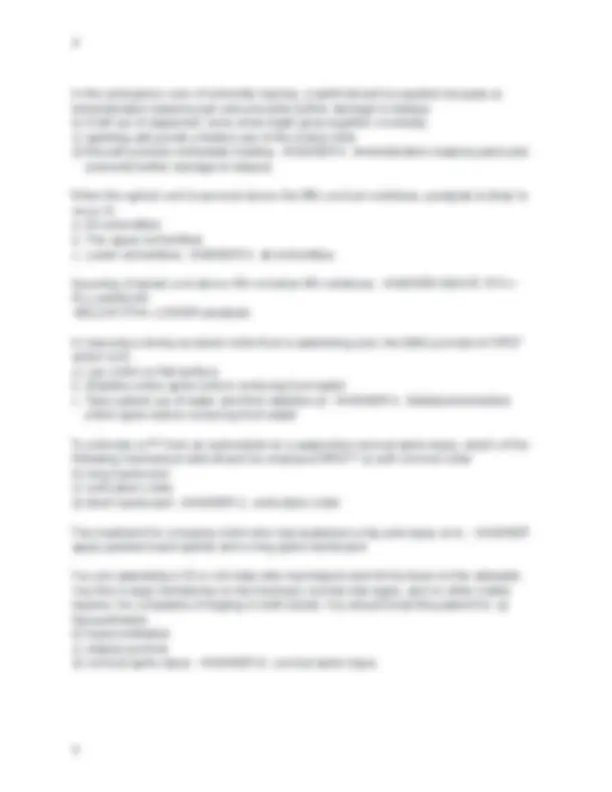
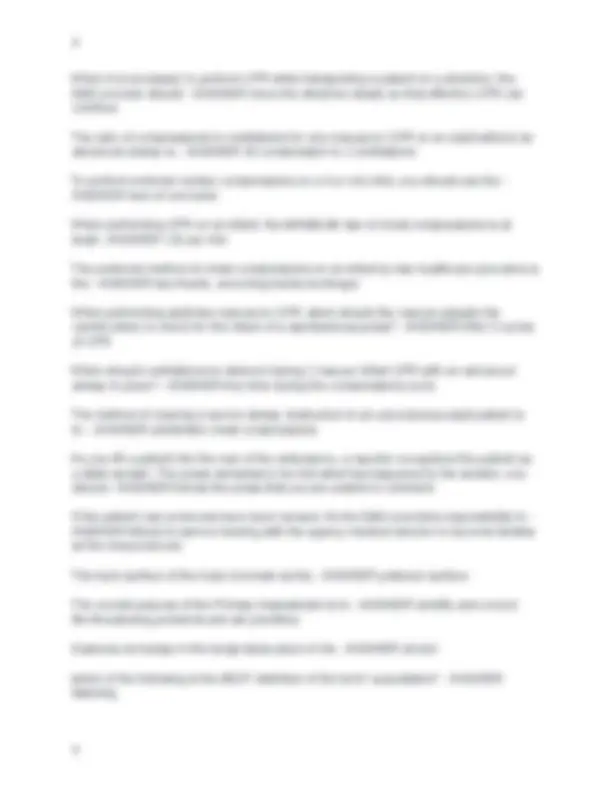
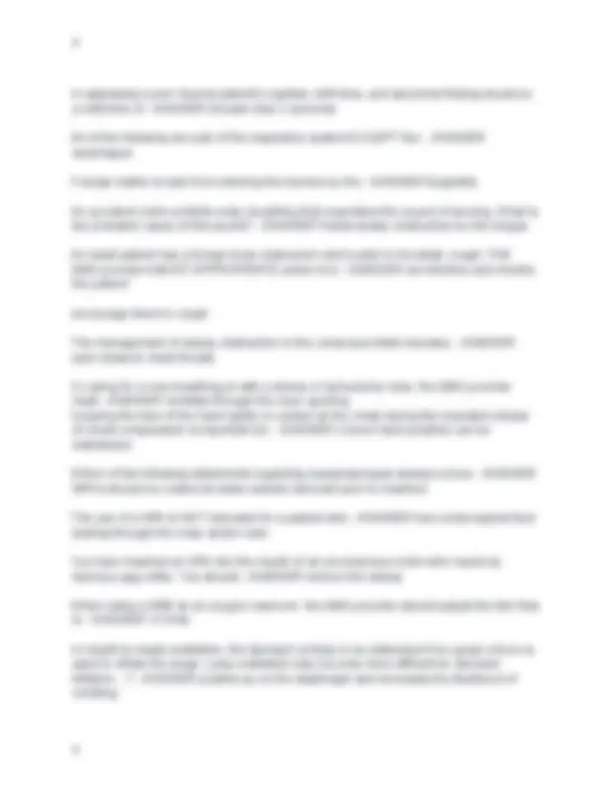
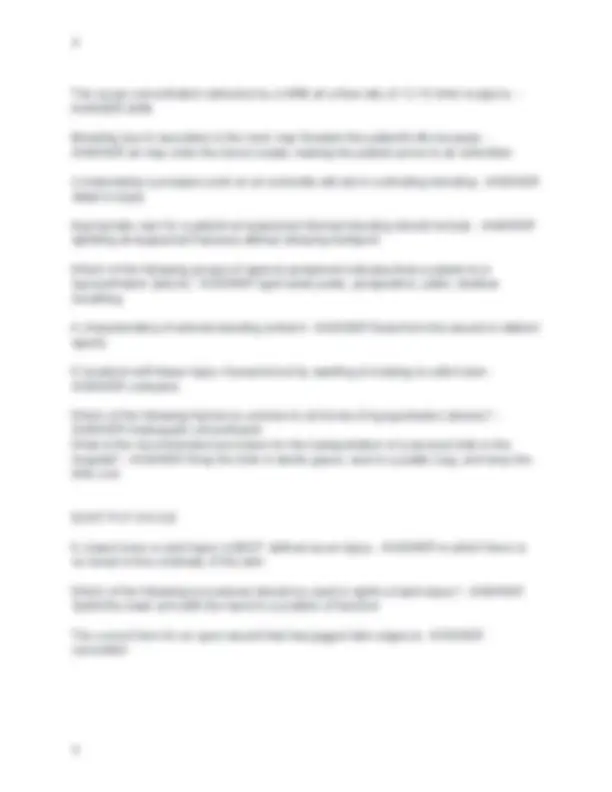
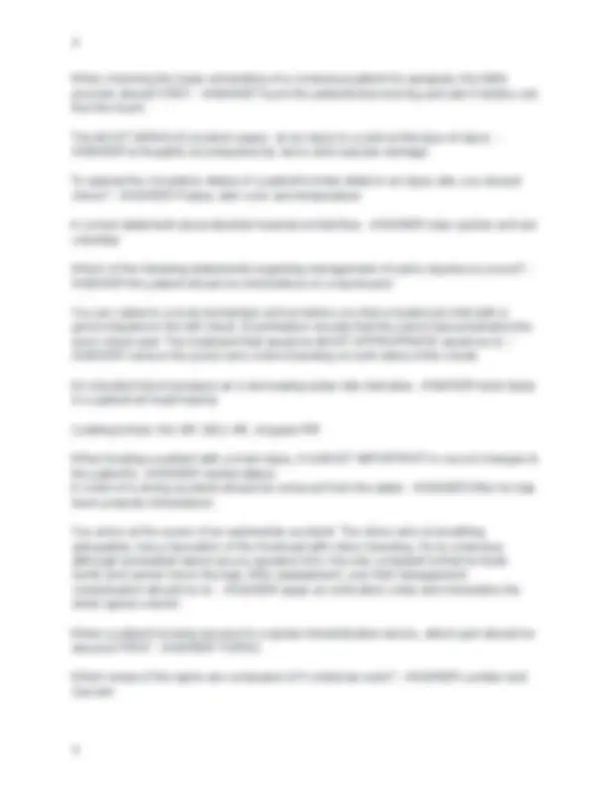
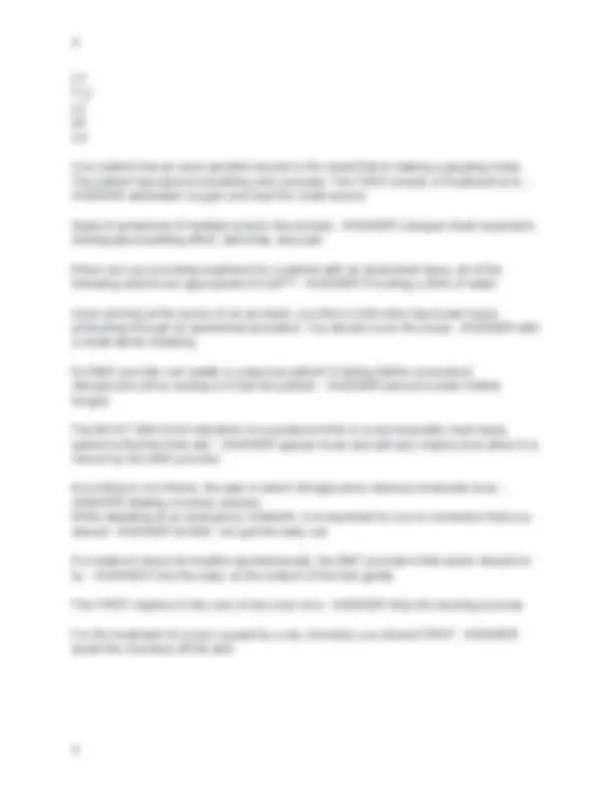
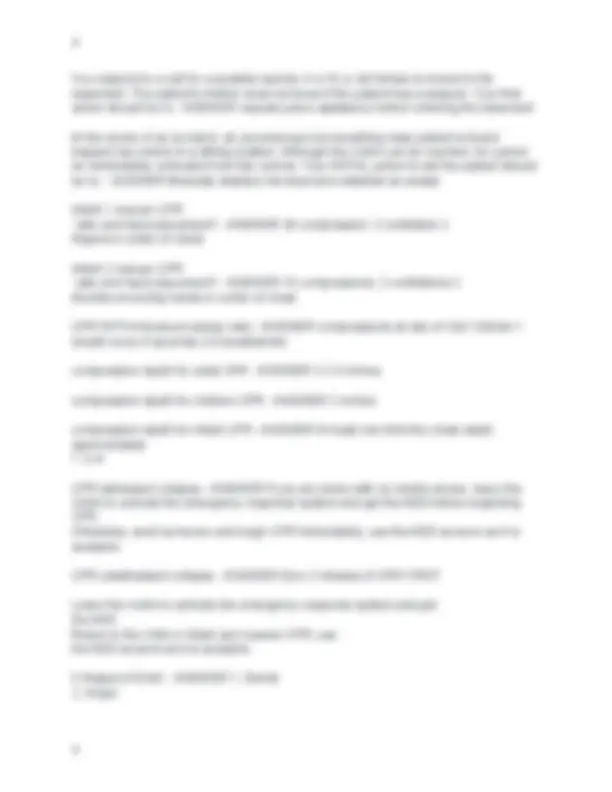
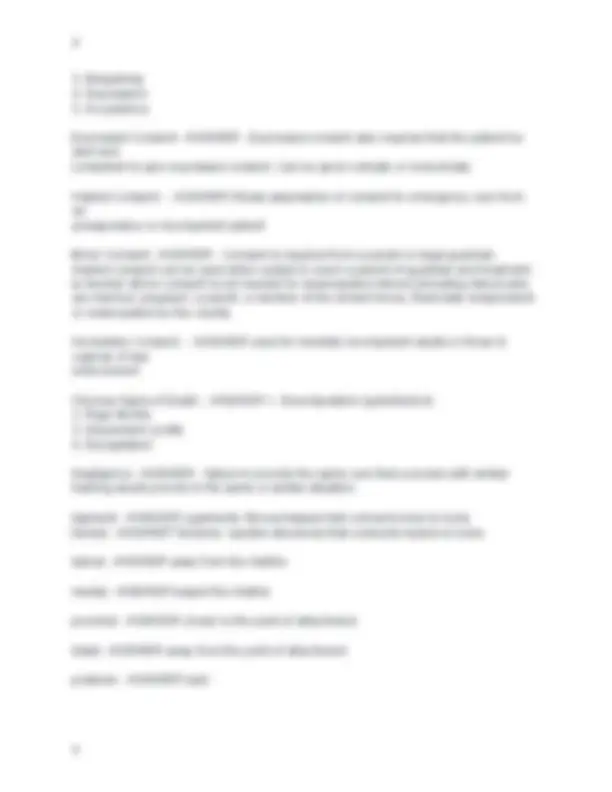
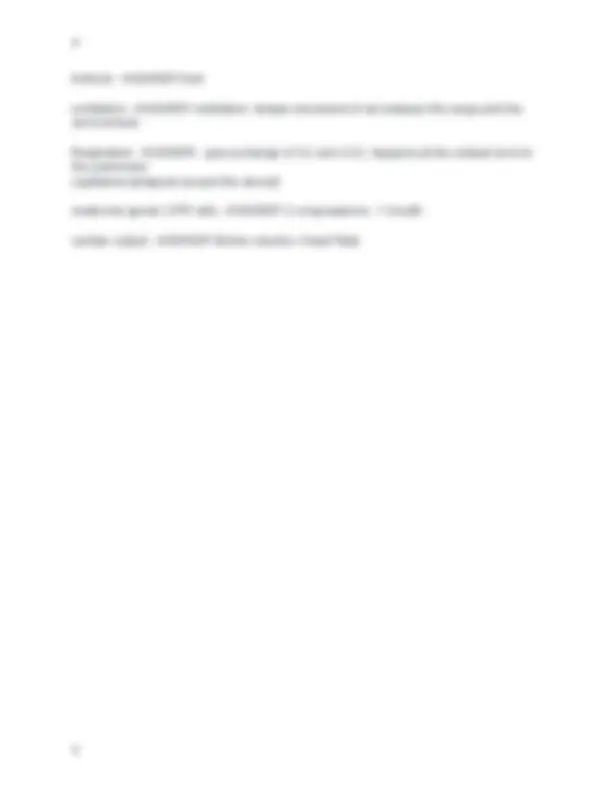


Study with the several resources on Docsity

Earn points by helping other students or get them with a premium plan


Prepare for your exams
Study with the several resources on Docsity

Earn points to download
Earn points by helping other students or get them with a premium plan
Community
Ask the community for help and clear up your study doubts
Discover the best universities in your country according to Docsity users
Free resources
Download our free guides on studying techniques, anxiety management strategies, and thesis advice from Docsity tutors
Which one of the following instructions applies to the performance of mask-to-stoma ventilation on a person who has had a COMPLETE laryngectomy? a. the nose and mouth must be manually sealed off b. perform Head tilt neck lift maneuver to open the airway c. the nose must be sealed off d. neither the nose nor mouth must be sealed off - ANSWER d. neither the nose nor mouth must be sealed off In performing an ongoing assessment on a 10-yr old pedestrian struck by a MV, the EMS provider's first step is to, a) recheck vital signs b) repeat the primary assessment c) check the interventions d) repeat a rapid assessment - ANSWER b) repeat the primary assessment
Typology: Exams
1 / 25

This page cannot be seen from the preview
Don't miss anything!


















Which one of the following instructions applies to the performance of mask-to-stoma ventilation on a person who has had a COMPLETE laryngectomy? a. the nose and mouth must be manually sealed off b. perform Head tilt neck lift maneuver to open the airway c. the nose must be sealed off d. neither the nose nor mouth must be sealed off
a) ask family members of the patients if there's a history of COPD b) assist patient's respiratory efforts w/ high conc oxygen using a BVM c) watch patient carefully and obtain vital signs d) assess the use of accessory muscles while breathing
- ANSWER b) assist patient's respiratory efforts w/ high conc oxygen using a BVM You are assessing a patient who complains of difficulty breathing and of "not getting enough air" Which of the following will quickly CONFIRM that the pt is not getting sufficient oxygen? A. pink nail beds B. smell of nail polish C. use of accessory muscles while breathing - ANSWER C. the use of accessory muscles while breathing While carrying concrete blocks at a construction site, a 58 yr old man suddenly develops chest pain and shortness of breath- appears frightened, vomits, and has cool clammy skins. thse are probably signs of a- hiatal hernia b- heat exhaustion c- fatigue d- heart attack - ANSWER D. heart attack A building contractor, under tremendous pressure to meet a job deadline, experiences diffuse pain in his chest. The pain lasts for several minutes, then disappears w/ rest. The EMS provider should suspect a- angina pectoris b- muscular cramps c- pulmonary edema d- congestive heart failure - ANSWER A. angina pectoris What acute disorder of the Cardiovascular system is caused by sudden blockage of coronary arteries a. Angina pectoris b. Myocardial infarction c. Stroke
For a trauma victim w/ a respiratory rate of 40/min, shallow and irregular, who is pale and has a history of emphysema, the MOST APPROPRIATE treatment would be to: a. use of a bvm w/ supp oxygen b. administer low-conc oxygen b/c of emphysema history c. administer supp oxygen w/ a high-conc mask d. transport the patient sitting up to ease the patient's dyspnea
- ANSWER A. Use of a BVM w/ supp. oxygen If the EMS provider is unable to find a patient's peripheral pulse during a Primary Assessment, next step should be to: a. turn on the AED b. palpate the carotid pulse c. open the airway and insert an OPA d. check breathing and begin CPR - ANSWER b. palpate the carotid pulse While assessing the MOI of a motor vehicle crash, an EMS provider finds that the airbag has been deployed: The EMS provider should: a. decontaminate the patient b. remove the airbag c. disconnect the battery d. lift the airbag and check underneath for damage - ANSWER d. lift the airbag and check underneath for damage If life threatening conditions are identified during the focused history and physical exam, the EMT should immediately: a. repeat the Primary Assessment b. take vital signs c. begin transportation efforts d. provide life-saving interventions - ANSWER D. provide life-saving interventions
An EMS Provider responds to a call and finds an 8- yr old female with no pulse or respirations. The patient has a history of terminal brain cancer. The family states the last time she as seen alive was 5 mins prior to EMS being called. They also state patient has a DNR oder. In NYS, EMS personnel may accept which of the following DNR instruments as valid? Verbal request from family A. Written non-hospital B. DNR or MOLST form C. Written healthcare proxy D. Written living will
- ANSWER Written out-of-hospital DNR OR MOLST FORM Implied Consent exists when a patient is suffering from a life-threatening injury or illness and is: a. Under police custody b. A threat to himself and others c. Under age of 18 d. Unconscious - ANSWER D. unconscious The opposite of distal is a. Superior b. Medial c. Lateral d. Proximal - ANSWER D. Proximal The chamber of the heart that is most muscular and that pumps the most blood into the aorta is the a. Right atrium b. Left ventricle c. Right ventricle d. Left atrium - ANSWER B. LEFT VENTRICLE In correct sequence (VERTEBRAE SECTIONS) and number in each section - ANSWER cervical (7), thoracic (5), lumbar (12), sacral (5), and coccygeal (4) The purpose of the first set of vital signs is to: - ANSWER A. establish a baseline for additional evaluations
For a patient with a suspected lumbar spinal injury, the BEST device for moving the patient as a single unit over uneven terrain is the: A. wheeled stretcher B. long spine board C. flexible stretcher D. short spine board – ANSWER B. long spine board Which of the following is the best indicator of the quality of ventilations A. chest expansion B. pupil size C. blood pressure D. skin color
- ANSWER A. CHEST EXPANSION What is the best measure of respiration? - ANSWER skin color ventilation vs respiration - ANSWER ventilation- the simple movement of air into and out of the lungs respiration- the exchange of gases between the lungs, the blood, and the tissues of the body Unless additional suctioning time is necessary to clear the airway, an adult patient should be suctioned for NO LONGER THAN A. 5 sec B. 10 sec C. 15 sec D. 20 sec
C. 1 - 2 seconds
do after injection : Massage area, dispose in sharps container A child drank some unknown fluid. You arrive at the scene and note the following signs: Child's mouth and lips are burned, child is coughing and gagging. What should you do? a) administer syrup of ipecac b) administer activated charcoal and induce vomiting c) call the medical or poison control center for advice d) administer syrup of ipepac and activated charcoal - ANSWER c- call the medical or poison control center for advice
How would you describe bleeding from a vein - ANSWER Dark red, flowing steadily To control a nosebleed in a patient WITHOUT suspected spinal traujma, the EMS provider should - ANSWER pinch the patient's nostrils together and sit the patient leaning forward to allow drainage All of the following cojnditions can lead to hypoperfusion (SHOCK) except: A. dilated blood vessels/pooling blood in extremities B. loss of fluid volume C. inc fluid volume D. dec cardiac output - ANSWER increased fluid volume A localized soft tissue injury characterized by swelling and bruising a. Contusion b. Avulsion c. Laceration d. Abrasion - ANSWER contusion Contusion Avulsion: Laceration: Abrasion: Definitions - ANSWER Contusion Bruise Avulsion: flap Laceration: jagged cut Abrasion: road rash You are treating a male patient who has a penetrating chest wound and frothy bright-red blood at the mouth. About 10 minutes after sealing the chest wall, you notice the patient's breathing becoems much worse. At this point you should, a) immediately place the patient on the uninjured side b) lift one corner of the dressing c) administer positive-pressure ventilation immediately d) administer pure oxygen to aid respiration - ANSWER b) lift one corner of the dressing Which of the following best describes an evisceration - ANSWER bowel loops protruding through the abdomen tension pneumothorax - ANSWER a type of pneumothorax in which air that enters the chest cavity is prevented from escaping mediastinum includes - ANSWER heart, aorta, esophagus, trachea, thymus gland
Which of the following BEST describes evisceration - ANSWER Bowel loops protruding through the abdomen Treatment: Cover with moist sterile dressing keep warm A patient was pulled from a house fire and has burns involving arms, chest and back. You should FIRST - ANSWER assess for airway and respiratory distress An adult has suffered partial thickness burns over the chest, abdomen, back, buttocks, and right arm. According to rule of 9's, what percentage of body surface has been burned? - ANSWER 45% Rule of 9's Chest Abdomen Back Buttocks Right arm Anterior of one arm? - ANSWER Chest- 9, Abdomen- 9 back- 9 buttocks-9 right arm- 9 anterior of right arm: 4. Which one of the following statements regarding burns is INCORRECT? a) Full thickness burns inolving the hands, face or feet are considered critical burns b) Burns occuring in patients w/ heart conditions should be considered critical c) Electrical burns usually cause insignificant damage to the underlying soft tissues d) Chemical antidotes should never be used to neutralize burns of the eyes - ANSWER C- electric burns usually cause insignificant damage to the underlying soft tissues An EMS provider is called to the scene where a victim has sustained an electrical burn. It is important for the EMS provider to: a. Immediately connect AED b. Check patient for entry and exit wounds c. Immediately pulls the patient from electrical source d. Administer oxygen to the patient via nasal cannula - ANSWER B. check the patient for entry and exit wounds What should you do first for a victim who shows signs of an injured shoulder? - ANSWER Manually stabilize the injury site When the bone ends of a joint are out place, the injury is called a - ANSWER dislocation
Infants are obligate nose breathers until approx. 6 months of age, which means that they a) should never be given 02 by a nasal cannula b) should never be placed on their stomachs fro breathing c) may suffer respiratory distress if their noses become obstructed d) are at a high risk for dying of SIDS - ANSWER C. may suffer respiratory distress if their noses become obstructed In a child, all of the following are signs of respiratory failure except? a) limp muscle tone b) cyanosis c) slow HR d) crying - ANSWER D. CRYING All of the following statements concerning SIDS are true except: a) it is preventable if parents are more attentive to their children b) if EMS provider arrives shortly after infants arrest, should administer CPR c) it is defined as the death of an infant that is sudden, unsuspected, and unexplainable d) if the infant shows very obvious signs of death, the EMS provider should hep the family deal wit htheir grief and guilt - ANSWER a- it is preventable are more attentitive to their children Which of the following is a condition commonly found in children and is characterized by fever, diarrhea, vomiting and sunken eyes? a. Dehydration b. Seizures c. Hypoglycemia d. Croup - ANSWER A. DEHYDRATION Sunken fontanelle vs bulging - ANSWER sunken: dehydration bulging fontanelle: inter cranial pressure Which of the following is an effective method of quickly assessing the circulatory status of a pediatric trauma victim? - ANSWER Squeezing patient's finger to check capilary refill THE MOST COMMON CAUSE OF SEIZURES IN CHILDREN IS a. Fever b. Airway obstruction c. Epilepsy - ANSWER FEVER (febrile seizure- contracts illness/infection, fever results) rapid rise in temp Because of the relatively large size of the head, spinal immobilization for infants and children should include padding of the a) hips
b) head c) neck d) shoudlers - ANSWER D. shoulder If you suspect that a patient is a victim of child abuse, you should - ANSWER notify your local child protective agency and complete the DSS form When treating an injured child suspected of being a victim of child abuse, your PRIMARY responsibility is to a. Asses and provide appropriate care for child b. Report to police c. Accuse parents d. Ask child - ANSWER A. assess and provide appropriate care The operator of an emergency vehicle must remember that NYS Vehicle and Traffic law grants all of the following privileges to emergency vehicles to drive light and sirens when: a. Transporting a patient in full cardiac arrest b. Transporting stable patient to emergency room c. Proceeding through red light with due caution - ANSWER c. Proceeding through red light with due caution Upon arrival at a MVA, an EMS provider should immediately assess the scene for safety, determine the # of patients and the mechanism of injury, and - ANSWER take body substance isolation precautions Which of the following is/are the MOST IMPT personal safety items when responding to an emergency is: - ANSWER a. Seatbelt and shoulder harness In triage, which of the following injuries would be considered to have the HIGHEST priorities (red) - ANSWER Severe uncontrolled bleeding, open abdominal wounds, severe head injury A single EMS provider finds a non breathing and pulseless victim of a mva lying face down in the road, and suspects the victim has a spinal injury. The EMS provider should
In assessing a ped. trauma patient's capillary refill time, and abnormal finding would be a refill time of - ANSWER Greater than 2 seconds All of the following are part of the respiratory system EXCEPT the: - ANSWER esophagus Foreign matter is kept from entering the trachea by the - ANSWER Epiglottis An accident victim exhibits noisy breathing that resembles the sound of snoring. What is the probable cause of this sound? - ANSWER Partial airway obstruction by the tongue An adult patient has a foreign body obstruction and is able to forcefully cough. THE EMS provider's MOST APPROPRIATE action is to - ANSWER not interfere and monitor the patient encourage them to cough The management of airway obstruction in the conscious infant includes: - ANSWER back blows & chest thrusts In caring for a non-breathing pt with a stoma or tacheotomy tube; the EMS provider must - ANSWER Ventilate through the neck opening Keeping the heel of the hand lightly in contact w/ the chest during the relaxation phase of chest compression is important b/c - ANSWER Correct hand position can be maintained Which of the following statements regarding nasopharyngeal airways is true - ANSWER NPA's should be coated w/ water-soluble lubricant prior to insertion The use of a NPA is NOT indicated for a patient who - ANSWER has cerebrospinal fluid leaking through the nose and/or ears You have inserted an OPA into the mouth of an unconscious vicitm who reacts by having a gag reflex. You should - ANSWER remove the airway When using a NRB w/ an oxygen reservoir- the EMS provider should adjust the liter flow to - ANSWER 15 l/min In mouth-to-mask ventilation, the stomach is likely to be distended if too great a force is used to inflate the lungs. Lung ventilation may become more difficult b/c stomach inflation....? - ANSWER pushes up on the diaphragm and increases the likelihood of vomiting
The oyxge concentration delivered by a NRB w/ a flow rate of 12-15 l/min is approx. - ANSWER 90% Bleeding due to laceration in the neck may threaten the patient's life because - ANSWER air may enter the blood vessel, making the patient prone to air embolism Compressing a pressure point on an extremity will aid in controlling bleeding - ANSWER distal to injury Appropriate care for a patient w/ suspected internal bleeding should include - ANSWER splinting all suspected fractures without delaying transport Which of the following groups of signs & symptoms indicates that a patient is in hypoperfusion (shock) - ANSWER rapid weak pulse, perspiration, pallor, shallow breathing A characteristics of arterial bleeding is that it - ANSWER flows from the wound in distinct spurts A localized soft tissue injury characterized by swelling & bruising is called a/an - ANSWER contusion Which of the following factors is common to all forms of hypoperfusion (shock)? - ANSWER Inadequate cell perfusion What is the recommended procedure for the transportation of a severed limb to the hospital? - ANSWER Wrap the limb in sterile gauze, seal in a plastic bag, and keep the limb cool DONT PUT ON ICE A closed bone or joint injury is BEST defined as an injury - ANSWER In which there is no break in the continuity of the skin Which of the following procedures should be used to splint a hand injury? - ANSWER Splint the lower arm with the hand in a position of function The correct term for an open wound that has jagged skin edges is - ANSWER Laceration